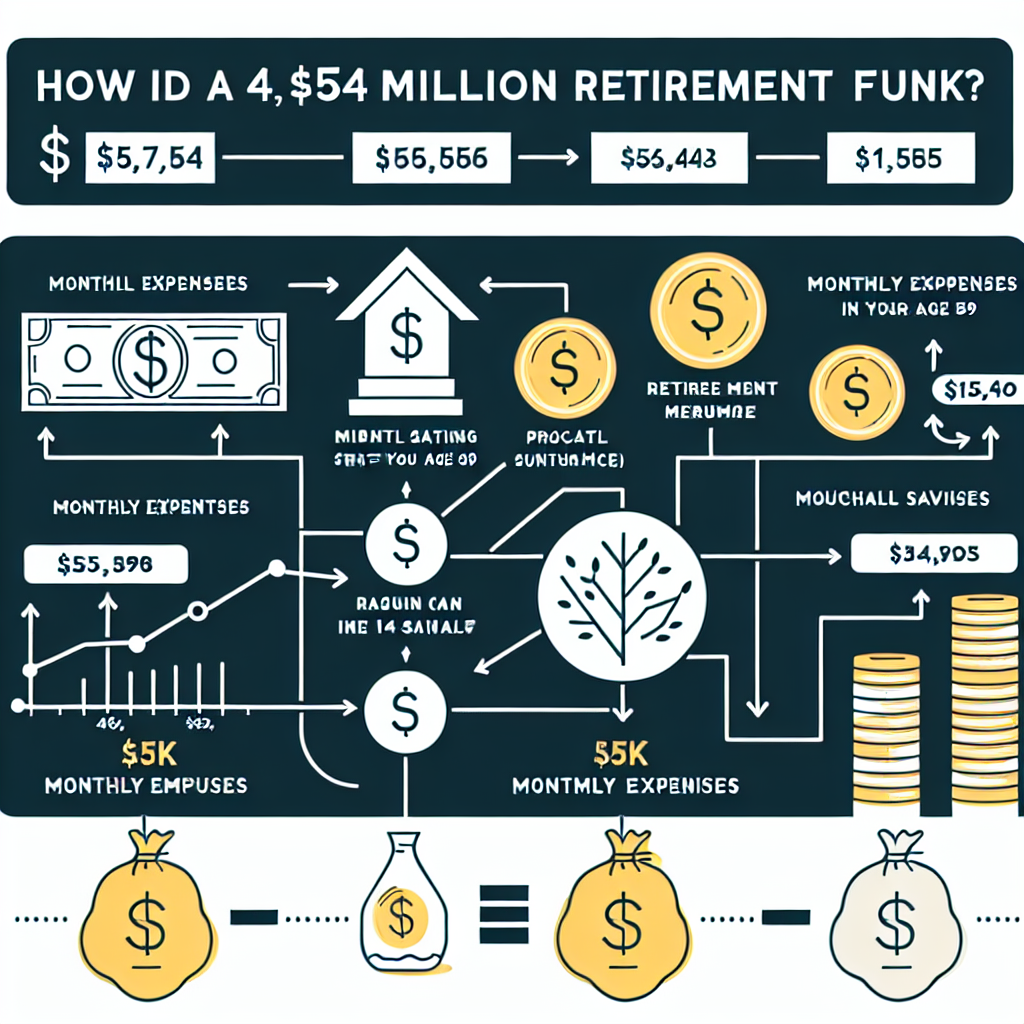“Secure Your Future: Can $1.4 Million Fund Your $5k Monthly Retirement Dream at 59?”
Introduction
Retirement planning is a critical aspect of financial management, especially when considering early retirement at age 59. One of the key questions retirees face is whether their savings can sustain their desired lifestyle. For an individual with $1.4 million in retirement savings, determining if this amount can support $5,000 in monthly expenses requires careful analysis of various factors. These include expected investment returns, inflation rates, life expectancy, healthcare costs, and potential changes in spending patterns over time. By examining these elements, retirees can better understand the sustainability of their financial resources and make informed decisions to ensure a comfortable and secure retirement.
Understanding Retirement Expenses: Can $1.4 Million Cover $5k Monthly at 59?
As individuals approach retirement, one of the most pressing questions they face is whether their savings will be sufficient to sustain their desired lifestyle. For someone retiring at age 59 with $1.4 million in savings, the prospect of maintaining $5,000 in monthly expenses is a critical consideration. To determine the feasibility of this financial plan, it is essential to examine several factors, including life expectancy, investment returns, inflation, and potential unexpected costs.
First and foremost, life expectancy plays a significant role in retirement planning. Retiring at 59 means potentially planning for a retirement that could last 30 years or more, depending on health and longevity. This extended period necessitates a careful assessment of how long the $1.4 million can last while covering $5,000 in monthly expenses, which amounts to $60,000 annually. Without additional income sources, such as Social Security or part-time work, the savings must be strategically managed to avoid depletion.
Investment returns are another crucial factor in this equation. Assuming a conservative annual return of 4% on the $1.4 million, the portfolio could generate approximately $56,000 in the first year. This return nearly covers the $60,000 annual expense, but it is important to consider that investment returns can fluctuate due to market volatility. Therefore, maintaining a diversified portfolio that balances risk and return is essential to ensure that the savings can sustain the desired lifestyle over the long term.
Inflation is an inevitable factor that can erode purchasing power over time. Even a modest inflation rate of 2% can significantly impact the real value of money over a 30-year period. To counteract this, retirees must consider strategies to protect their savings from inflationary pressures. This might involve investing in assets that historically outpace inflation, such as equities or real estate, to preserve the purchasing power of their savings.
Moreover, unexpected costs can arise during retirement, potentially derailing even the most well-thought-out financial plans. Healthcare expenses, for instance, tend to increase with age and can be substantial, especially if long-term care becomes necessary. It is prudent to allocate a portion of the retirement savings to cover such contingencies, either through insurance products or by setting aside a dedicated emergency fund.
In addition to these considerations, retirees should also explore other income sources that can supplement their savings. For instance, delaying Social Security benefits until a later age can result in higher monthly payments, providing a more substantial income stream in the later years of retirement. Additionally, part-time work or consulting can offer both financial benefits and personal fulfillment, helping to bridge any potential gaps between expenses and available funds.
In conclusion, while $1.4 million can potentially sustain $5,000 in monthly expenses for someone retiring at age 59, it requires careful planning and management. By considering factors such as life expectancy, investment returns, inflation, and unexpected costs, retirees can develop a comprehensive strategy to ensure their savings last throughout their retirement years. Diversifying investments, protecting against inflation, and exploring additional income sources are all vital components of a successful retirement plan. With thoughtful preparation and prudent financial management, retirees can enjoy a comfortable and secure retirement.
Investment Strategies for Early Retirement: Maximizing $1.4 Million
As individuals approach the prospect of early retirement, the question of whether a nest egg of $1.4 million can sustain a monthly expenditure of $5,000 becomes increasingly pertinent. This scenario, particularly for someone retiring at the age of 59, requires a careful examination of investment strategies and financial planning to ensure longevity and stability of funds. The challenge lies in balancing the need for immediate income with the preservation of capital over an extended retirement period, potentially spanning several decades.
To begin with, it is essential to consider the withdrawal rate, a critical factor in determining the sustainability of retirement savings. The commonly referenced 4% rule suggests that retirees can withdraw 4% of their initial retirement portfolio annually, adjusted for inflation, without depleting their funds over a 30-year period. Applying this rule to a $1.4 million portfolio results in an annual withdrawal of $56,000, or approximately $4,667 per month. This figure is slightly below the desired $5,000 monthly expenditure, indicating the need for strategic adjustments.
One approach to bridging this gap is to optimize the investment portfolio for growth while managing risk. Diversification across asset classes, such as stocks, bonds, and real estate, can provide a balance between growth potential and income generation. Equities, particularly dividend-paying stocks, can offer both capital appreciation and a steady income stream. Meanwhile, bonds can provide stability and regular interest payments, albeit with lower returns. Real estate investments, whether through direct ownership or real estate investment trusts (REITs), can also contribute to a diversified income stream.
Moreover, it is crucial to consider the impact of inflation on purchasing power over time. Inflation erodes the value of money, making it imperative for the investment portfolio to generate returns that outpace inflation. Historically, equities have been one of the best hedges against inflation, but they come with higher volatility. Therefore, maintaining a well-balanced portfolio that includes inflation-protected securities, such as Treasury Inflation-Protected Securities (TIPS), can help mitigate this risk.
In addition to investment strategies, tax efficiency plays a significant role in maximizing retirement income. Utilizing tax-advantaged accounts, such as Roth IRAs or 401(k)s, can help minimize tax liabilities on withdrawals. Furthermore, strategically timing withdrawals from taxable and tax-deferred accounts can optimize tax outcomes and extend the longevity of the retirement portfolio.
Another consideration is the potential for part-time work or alternative income sources during retirement. Engaging in consulting, freelancing, or pursuing a passion project can provide supplementary income, reducing the reliance on retirement savings. This not only alleviates financial pressure but also offers personal fulfillment and engagement during retirement years.
Finally, regular reassessment of financial goals and portfolio performance is essential. Life circumstances, market conditions, and personal priorities can change, necessitating adjustments to the retirement plan. Consulting with a financial advisor can provide valuable insights and help navigate complex financial decisions.
In conclusion, while retiring at 59 with $1.4 million and sustaining $5,000 in monthly expenses presents challenges, it is achievable with careful planning and strategic investment. By focusing on a diversified portfolio, tax efficiency, and potential supplementary income, retirees can enhance the sustainability of their funds and enjoy a financially secure retirement.
Inflation and Its Impact on $5k Monthly Expenses in Retirement
As individuals approach retirement, financial planning becomes a critical component of ensuring a comfortable and sustainable lifestyle. One of the most pressing concerns for retirees is whether their savings will be sufficient to cover their anticipated expenses. For those retiring at age 59 with $1.4 million in savings, the question arises: can this amount sustain $5,000 in monthly expenses throughout retirement? To address this, it is essential to consider the impact of inflation on purchasing power and how it can affect long-term financial stability.
Inflation, the gradual increase in prices over time, erodes the purchasing power of money. This means that the $5,000 needed for monthly expenses today will not have the same value in the future. Historically, inflation rates have varied, but a common benchmark used in financial planning is an average annual inflation rate of around 3%. At this rate, the cost of living could potentially double in approximately 24 years. Therefore, retirees must account for inflation when determining whether their savings will be adequate.
To illustrate the impact of inflation, consider a retiree who plans to withdraw $5,000 monthly from their $1.4 million savings. Initially, this withdrawal rate may seem sustainable. However, as inflation increases the cost of goods and services, the retiree will need to withdraw more money to maintain the same standard of living. For instance, if inflation averages 3% annually, the retiree would need to withdraw approximately $6,720 per month in 10 years to match the purchasing power of $5,000 today. This increase in withdrawals can significantly deplete savings over time.
Moreover, it is crucial to consider the investment strategy employed during retirement. A well-diversified portfolio that includes a mix of stocks, bonds, and other assets can help mitigate the effects of inflation by providing growth potential. Historically, equities have outpaced inflation, offering higher returns that can help preserve the purchasing power of retirement savings. However, investing in stocks also involves risks, and market volatility can impact the value of a retiree’s portfolio. Therefore, a balanced approach that aligns with the retiree’s risk tolerance and financial goals is essential.
Additionally, retirees should explore other strategies to combat inflation. One such strategy is the use of inflation-protected securities, such as Treasury Inflation-Protected Securities (TIPS), which adjust their principal value based on changes in the Consumer Price Index (CPI). These securities can provide a hedge against inflation, ensuring that the retiree’s income keeps pace with rising costs.
Furthermore, retirees may consider adjusting their spending habits to accommodate inflationary pressures. This could involve prioritizing essential expenses and being flexible with discretionary spending. By adopting a dynamic approach to budgeting, retirees can better manage their finances and extend the longevity of their savings.
In conclusion, while $1.4 million may initially appear sufficient to cover $5,000 in monthly expenses for a retiree at age 59, the impact of inflation cannot be overlooked. To ensure financial security throughout retirement, it is imperative to account for inflation in financial planning, adopt a diversified investment strategy, and remain adaptable in spending habits. By doing so, retirees can better navigate the challenges posed by inflation and enjoy a more stable and fulfilling retirement.
Longevity Risk: Will $1.4 Million Last Through Retirement Starting at 59?

When contemplating retirement at the age of 59 with a nest egg of $1.4 million, one of the most pressing concerns is whether this sum can sustain a monthly expenditure of $5,000 throughout the retirement years. This question is not merely about simple arithmetic; it involves a complex interplay of factors such as longevity risk, inflation, investment returns, and unexpected expenses. Understanding these elements is crucial for anyone planning to retire early and maintain a comfortable lifestyle.
To begin with, longevity risk is a significant consideration. With advancements in healthcare and living standards, life expectancy has increased, meaning retirees today may need their savings to last longer than previous generations. Retiring at 59 could mean planning for a retirement period that spans 30 years or more. This extended timeframe amplifies the risk of outliving one’s savings, making it essential to carefully assess whether $1.4 million is sufficient to cover $5,000 in monthly expenses over such a duration.
Moreover, inflation is another critical factor that can erode the purchasing power of retirement savings. Even a modest inflation rate can significantly impact the real value of money over time. For instance, with an average inflation rate of 3%, the purchasing power of $5,000 today would be equivalent to approximately $2,700 in 20 years. Therefore, retirees must consider how inflation will affect their ability to maintain their desired lifestyle and whether their investment strategy can outpace inflation.
Investment returns play a pivotal role in determining the sustainability of retirement savings. A well-diversified portfolio that balances risk and return is essential to ensure that the $1.4 million continues to grow, even as withdrawals are made. Historically, a balanced portfolio of stocks and bonds has provided a reasonable return, but market volatility and economic downturns can pose challenges. Retirees must be prepared for fluctuations in their investment returns and have a strategy in place to mitigate these risks.
Additionally, unexpected expenses, such as healthcare costs, can significantly impact retirement savings. As individuals age, healthcare needs often increase, and without adequate insurance coverage, these costs can quickly deplete savings. It is crucial to factor in potential healthcare expenses and consider options such as long-term care insurance to protect against unforeseen financial burdens.
Furthermore, the sequence of returns risk is an often-overlooked aspect that can affect the longevity of retirement savings. This risk refers to the order in which investment returns occur and can have a profound impact on a retiree’s portfolio, especially in the early years of retirement. Negative returns early on can deplete savings faster than anticipated, making it essential to have a withdrawal strategy that accounts for this risk.
In conclusion, while $1.4 million may seem like a substantial sum, whether it can sustain $5,000 in monthly expenses starting at age 59 depends on various factors. Longevity risk, inflation, investment returns, unexpected expenses, and sequence of returns risk all play crucial roles in determining the sustainability of retirement savings. Therefore, it is imperative for individuals to conduct thorough financial planning, possibly with the assistance of a financial advisor, to ensure that their retirement years are financially secure and fulfilling.
Diversifying Income Streams: Beyond $1.4 Million for a Secure Retirement
As individuals approach retirement, the question of whether their savings will suffice to maintain their desired lifestyle becomes increasingly pertinent. For those with $1.4 million in savings, the prospect of sustaining $5,000 in monthly expenses at the age of 59 is a common concern. While this amount may seem substantial, it is crucial to consider various factors that could impact the longevity of these funds. Diversifying income streams beyond the initial savings can play a pivotal role in ensuring a secure and comfortable retirement.
To begin with, understanding the basic principles of withdrawal rates is essential. The 4% rule, a popular guideline among financial planners, suggests that retirees can withdraw 4% of their savings annually without depleting their funds over a 30-year period. Applying this rule to a $1.4 million portfolio would yield $56,000 per year, or approximately $4,667 per month. This figure is slightly below the desired $5,000 monthly expense, indicating that relying solely on the 4% rule may not suffice.
Moreover, inflation is a critical factor that can erode purchasing power over time. With an average inflation rate of around 2-3% per year, the real value of money decreases, necessitating higher withdrawals to maintain the same standard of living. Consequently, retirees must consider strategies to mitigate inflation’s impact, such as investing in assets that historically outpace inflation, like stocks or real estate.
In addition to traditional investment strategies, diversifying income streams can provide a buffer against market volatility and unforeseen expenses. One approach is to explore part-time work or consulting opportunities, which not only supplement income but also offer a sense of purpose and engagement. Furthermore, rental properties can serve as a reliable source of passive income, provided they are managed effectively. Real estate investments can also appreciate over time, offering potential capital gains.
Another avenue to consider is annuities, which can provide a steady income stream for life. While annuities can be complex and often come with high fees, they offer the advantage of guaranteed income, which can be particularly appealing in uncertain economic climates. It is advisable to consult with a financial advisor to determine if annuities align with one’s retirement goals and risk tolerance.
Additionally, retirees should not overlook the potential benefits of delaying Social Security benefits. By postponing claims until the age of 70, individuals can increase their monthly benefits significantly, providing a more substantial income stream later in life. This strategy can be particularly beneficial for those in good health with a longer life expectancy.
Finally, maintaining a flexible withdrawal strategy is crucial. Retirees should be prepared to adjust their spending in response to market conditions and personal circumstances. This flexibility can help preserve the longevity of their savings and ensure financial security throughout retirement.
In conclusion, while $1.4 million is a considerable sum, relying solely on this amount to sustain $5,000 in monthly expenses may not be sufficient, especially when considering inflation and market fluctuations. Diversifying income streams through part-time work, real estate investments, annuities, and strategic Social Security planning can provide additional financial security. By adopting a comprehensive approach to retirement planning, individuals can enhance their ability to enjoy a comfortable and fulfilling retirement.
The Role of Social Security in Supplementing $5k Monthly Expenses
When considering retirement at the age of 59 with $1.4 million in savings, a critical question arises: can this nest egg sustain $5,000 in monthly expenses? To address this, it is essential to explore the role of Social Security in supplementing these expenses. Social Security benefits, a cornerstone of retirement planning for many Americans, can significantly impact the sustainability of one’s retirement funds. However, understanding how these benefits integrate with personal savings is crucial for a comprehensive financial strategy.
At the outset, it is important to recognize that Social Security benefits are not immediately available to individuals retiring at 59. The earliest age to claim Social Security is 62, and doing so results in reduced benefits. Therefore, retirees must initially rely solely on their savings to cover expenses. This period, often referred to as the “bridge period,” requires careful financial planning to ensure that the $1.4 million is not prematurely depleted. During these years, retirees might consider drawing from their savings at a conservative rate, often recommended at around 3-4% annually, to maintain financial stability until Social Security benefits commence.
Once eligible, Social Security can provide a substantial supplement to monthly expenses. The amount received depends on several factors, including the individual’s earnings history and the age at which they begin to claim benefits. For those who delay claiming until reaching full retirement age, which is typically between 66 and 67, the benefits increase, providing a more robust financial cushion. This strategy, known as delayed retirement credits, can enhance the monthly benefit by up to 8% per year beyond full retirement age, up to age 70. Therefore, if feasible, delaying Social Security can be a strategic move to maximize long-term financial security.
Moreover, Social Security benefits are designed to replace a portion of pre-retirement income, with lower-income earners receiving a higher replacement rate than higher-income earners. This progressive structure means that for some retirees, Social Security can cover a significant portion of their monthly expenses, thereby reducing the reliance on personal savings. However, for those with higher pre-retirement earnings, the benefits may cover a smaller percentage, necessitating a more substantial draw from personal savings to meet the $5,000 monthly target.
In addition to the timing of benefits, retirees should consider the impact of taxes on Social Security income. Depending on total income levels, up to 85% of Social Security benefits may be taxable. This factor should be integrated into the overall retirement plan to ensure that net income aligns with expense needs. Furthermore, inflation is another critical consideration, as it can erode purchasing power over time. Social Security benefits are adjusted for inflation through cost-of-living adjustments (COLAs), providing some protection against rising costs. However, personal savings must also be managed to account for inflationary pressures.
In conclusion, while $1.4 million can potentially sustain $5,000 in monthly expenses, the integration of Social Security benefits plays a pivotal role in ensuring long-term financial stability. By strategically planning the timing of benefit claims and considering factors such as taxes and inflation, retirees can effectively supplement their savings and enhance their financial security. Ultimately, a well-rounded approach that combines personal savings with Social Security benefits can provide a sustainable path to a comfortable retirement.
Tax Considerations for Retirees: Managing $1.4 Million Efficiently
When contemplating retirement at the age of 59 with a nest egg of $1.4 million, one of the primary concerns is whether this sum can sustain a monthly expenditure of $5,000. To address this, it is crucial to consider various tax implications and strategies that can help manage these funds efficiently. Understanding the tax landscape is essential, as it can significantly impact the longevity of retirement savings.
Firstly, it is important to recognize that different types of retirement accounts are subject to varying tax treatments. For instance, withdrawals from traditional IRAs and 401(k) plans are generally taxed as ordinary income. Therefore, if a significant portion of the $1.4 million is held in these accounts, it is vital to plan withdrawals carefully to avoid being pushed into a higher tax bracket. Conversely, Roth IRAs offer tax-free withdrawals, provided certain conditions are met, which can be advantageous in managing tax liabilities.
Moreover, retirees should be aware of the age-related tax considerations. At 59, individuals are just past the age where they can withdraw from retirement accounts without incurring a 10% early withdrawal penalty. However, they are still several years away from the age of 72, when required minimum distributions (RMDs) from traditional retirement accounts begin. This window provides an opportunity to strategically manage withdrawals and potentially convert some funds from traditional accounts to Roth IRAs, thereby reducing future RMDs and associated taxes.
In addition to managing withdrawals, retirees should consider the impact of Social Security benefits on their tax situation. Although Social Security benefits can be claimed as early as age 62, delaying benefits can result in a higher monthly payout. This decision should be weighed against the need for immediate income and the tax implications of other income sources. It is also worth noting that up to 85% of Social Security benefits may be taxable, depending on the retiree’s total income.
Furthermore, investment income, such as dividends and capital gains, can also affect the tax burden. Long-term capital gains and qualified dividends are typically taxed at lower rates than ordinary income, which can be beneficial for retirees. However, it is essential to manage the timing of asset sales to optimize tax efficiency. For instance, selling assets in a year with lower income can minimize capital gains taxes.
Another consideration is the potential impact of state taxes. While some states do not tax retirement income, others may have significant tax implications. Retirees should evaluate their state’s tax policies and consider relocating if it offers a more favorable tax environment.
Finally, healthcare costs, including Medicare premiums, can also influence tax planning. Higher income levels can lead to increased Medicare premiums, known as Income-Related Monthly Adjustment Amounts (IRMAA). Therefore, managing taxable income can help mitigate these additional costs.
In conclusion, while $1.4 million can potentially sustain a $5,000 monthly expense in retirement, effective tax management is crucial to ensure the longevity of these funds. By understanding the tax implications of different income sources and strategically planning withdrawals, retirees can optimize their financial situation and enjoy a more secure retirement.
Q&A
1. **Question:** What is the annual withdrawal amount if monthly expenses are $5,000?
**Answer:** The annual withdrawal amount is $60,000 ($5,000 x 12 months).
2. **Question:** What is the initial withdrawal rate from a $1.4 million portfolio to cover $60,000 annually?
**Answer:** The initial withdrawal rate is approximately 4.29% ($60,000 / $1,400,000).
3. **Question:** How does the 4% rule apply to this scenario?
**Answer:** The 4% rule suggests that withdrawing 4% of your retirement savings annually is generally considered sustainable over a 30-year retirement period. A 4.29% withdrawal rate is slightly above this guideline.
4. **Question:** What factors could affect the sustainability of withdrawing $5,000 monthly from $1.4 million?
**Answer:** Factors include investment returns, inflation, unexpected expenses, and longevity.
5. **Question:** How might inflation impact the sustainability of these withdrawals?
**Answer:** Inflation reduces purchasing power over time, meaning the retiree may need to increase withdrawals to maintain the same standard of living, potentially depleting the portfolio faster.
6. **Question:** What role do investment returns play in sustaining the portfolio?
**Answer:** Positive investment returns can help replenish the portfolio, while negative returns can accelerate depletion. A balanced investment strategy is crucial.
7. **Question:** What strategies can be employed to ensure the portfolio lasts throughout retirement?
**Answer:** Strategies include adjusting withdrawal rates, diversifying investments, reducing expenses, and considering part-time work or annuities for additional income.
Conclusion
To determine if $1.4 million can sustain $5,000 in monthly expenses in retirement at age 59, we need to consider several factors, including life expectancy, investment returns, inflation, and withdrawal rates. Assuming a conservative annual withdrawal rate of 4%, which is often recommended for retirement planning, $1.4 million would allow for an annual withdrawal of $56,000, or approximately $4,667 per month. This is slightly below the $5,000 monthly expense target. However, if the portfolio achieves higher returns or if expenses can be adjusted, it may be feasible. Additionally, factors such as Social Security benefits, other income sources, and potential changes in expenses over time should be considered. Overall, while it is possible for $1.4 million to sustain $5,000 in monthly expenses, careful financial planning and management are essential to ensure long-term sustainability.





